Ukrainian Tanks & AFVs today
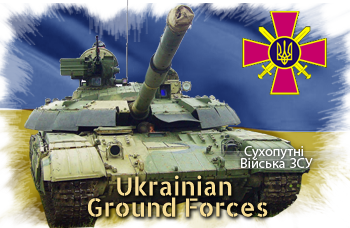
Ukraine, land of the Scythians
Ukraine for long had a specific posture, rather independent towards Russia, although forcibly integrated since the XVIIth century, notably to allow an access to the black sea. Crimea has been a highly strategic asset since. Ukraine has also the richest ancient archaeological remains from the mysterious Scythians through burial tombs (of which many treasures are now exposed at the Hermitage, St Petersburg). The large, barren steppes always seemed tailor-made for nomadic horsemen, and eventually will give Ukraine its own flag (the blue of the sky and yellow of the steppe).The Sarmatians later subjugated the Scythians and ruled this area for centuries (they also became part of the late Roman Army and perhaps the inspiration for the first chivalry). Kiev became a powerful and independent Kingdom funded on trade, the Kievan Rus formed their own chivalry with the Druzhina in medieval times. Ukraine has been also the haven for the Cossacks, misfits and exiled which formed the Zaporozhian Host and further cultivated this tradition of autonomy and independence while being famous as a buffer to the Islamic world and especially the Tatars in the XVII and XVIIIth century.
- T-84
- BM bulat
- BM-Oplot
- BMP-1U
- BTR-94 IFV
- BTR-3
- BTR-4E Butsefal
- BMM-4C
- BTR-4KSh (BTR-4)
- BTR-7
- BMM-70 Kovachev (BTR-7)
- Dozor-M
- Kozak-2
- KrAZ Shrek
- KrAZ Spartan
- Novator
- Varta
- 2S22 "Bohdana"
- BREM-4K
- BREM-84 "Atlet"
- 1АР1 "Polozhennya-2"
Main Battle Tanks
IFV/APCs
Other wheeled AFVs
Misc. AFVs
Soviet Ukraine (1917-1945)
Before the communists took over in 1917, Ukraine saw the origin of the revolution in the 1905 black sea insurrection (events around the Potemkin affair). During the civil war, several armies fought each other: The Army of the Ukrainian People's Republic, the anarchist Revolutionary Insurrectionary Army of Ukraine (or "black Russians"), Ukrainian Galician Army (white Russians) assisted with Sich Riflemen.Under ussr rule, this country remains the granary of Russia and provided the bulk of its oil reserves (around Baku) whereas Stalingrad became a major industrial hub. After Operation Barbarossa was launched in 1941, later frozen before Moscow and restarted in spring 1942, Ukraine rapidly fell to the rapid pace of blitzkrieg, reaching the Don.
SS exactions eventually nullified the sympathies Ukrainians initially had for what were called "liberators" from the Soviet rule. An ex-Ukrainian general, Vlasov was even at the head of a pro-German "Ukrainian Liberation Army" made of former prisoners (mostly Ukrainians), whereas some Cossack hosts became auxiliaries of the Wehrmacht. However, Stalingrad became the center of the war on the Eastern Front and saw a complete reversal of fortune for the Axis. From there, Germany and its allies were thrown into retreat, and the Ukrainians actively participated in all red army offensives, from the Don to the Rhine.
Ukraine in the Cold War (1947-1991)
The famous Morozov design bureau, from the Kharkiv locomotive factory, have been both central, instrumental in the conception and production of the T-34, in Ukraine. Early on with the T-12 and T-24 light tanks, the BT series, and the T-44. This expertise was carried out with the "two tanks policy" wanted by Moskow after the war, which traduced by the T-54. The development of the series was later passed on to the Kartsev Design Bureau at Uralvagonzavod, while Morozov started the revolutionary T-64 and eventually led to the T-80UD in the 1980s by what is known today as KMDB (M in honor of Morozov), which still pursue the development of new upgrades to this day. Outside these remarkable achievements, KMDB and the Malyshev factory delivered tens of thousands of Soviet vehicles of all types.All this industrial expertise was passed onto the newly independent state of Ukraine in 1991. At that time, the heritage from the Soviet era traduced as 780,000 personnel, 7,000 armored vehicles, 6,500 tanks, and 2,500 tactical nuclear missiles. Most were later dismantled, scrapped, or stored for future modernization. Today the nuclear park is drastically reduced, under the Missile Technology Control Regime (MTCR) program. International cooperation, (noteworthy the USA) ensured no known stockpiles left from the departure of Soviet forces ever joined the black market, avoiding the proliferation of relatively discreet nuclear heads.
The Ukrainian Army
As of 2014, pre-Donbass war, the total army personal (reserve, navy and air force included) was 280,000 strong, with 700,000 as a reserve. Conscription comprises 12 months of compulsory service whereas, in case of war, 11,149,646, age 16–49 are considered fit for service. The ground forces themselves were found at the head of the ex-soviet 1st Guards Army, 13th Army, 38th Army, 6th Guards and 8th Army (both tank armies), and the 32nd Army Corps, plus the 28th and 180th Guards Motor Rifle Division.Until 1992, they were commanded by the provisional Kiev Military District, later disbanded when the Ministry of Defence was properly organized. Colonel General Vasily Sobkov was the first ground army head of staff, named in 1994. Status of the ground forces was fixed by the Article 4 of the constitution. The 1st army corps became the Northern Territorial Operational Command, then Northern Operational Command in 1998 whereas the Carpathian Military District became the Southern Operational Command. The siege moves from Kiev to Odessa, and then to Donetsk. While the 2nd army corps was established, attack helicopter regiments were added organically to the new mechanized divisions/brigades (former motor rifle divisions).
The 2000 reforms
These were of first importance. In order to improve the general quality of the army, it was to be reduced to 250,000 by 2015, and the conscription abolished, for a fully professional army only. Lots of units and bases were dismantled. With the funds reallocated, modern equipment could be purchased and the frame for a better training established. In particula, in 2006, the Joint Rapid Reaction Forces (JRRF) was setup for participate in multinational exercises, both as a host in Ukraine or guest. Currently there are four training ranges and three military schools. Of course this all changed in 2022.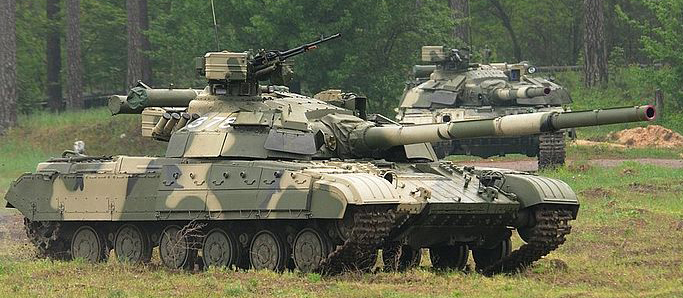
T-64BM Bulat. Around 120 of these well-modernized T-64 are given to elite batallions along with a few T-84BM Oplot.
In addition, the Ukrainian Army, like its soviet predecessor have an important airborne arm, now represented by the 25th, 79th, 80th, 81st and 95th Airmobile Brigades. In addition there are 60,000 internal security forces, the National Guard dependent of the Ministry of Internal Affairs, the volunteer Territorial defense battalion formed in 2014 to counter Russian insurgency, the border guards (50,000), Civil Defence Forces (10,000) and Special Transportation Service.
Assets: Ukrainian Tanks and AFVs
Actual composition of the Ukrainian ground forces includes the 1st, 17th and 30th Armored Brigades. At a larger scale, they are part of the 6th, 8th and 13th Army Corps. They are equipped with T-64 and T-64BM "Bulat" MBTs; BMP-1/2/3 IFVs, and BTR-60/70/80, wheeled APCs. The artillery branch is equipped with MRLs (Multiple rocket launcher) as the Smerch, Uragan and Grad and the soviet-era Giatsint, Pion, Akatsiya, and Gvozdika self-propelled howitzers.External operations
Ukrainian troops and AFVs participated in the Kosovo Force (KFOR), were present in the Iraq War, in Afghanistan (2001 to present day).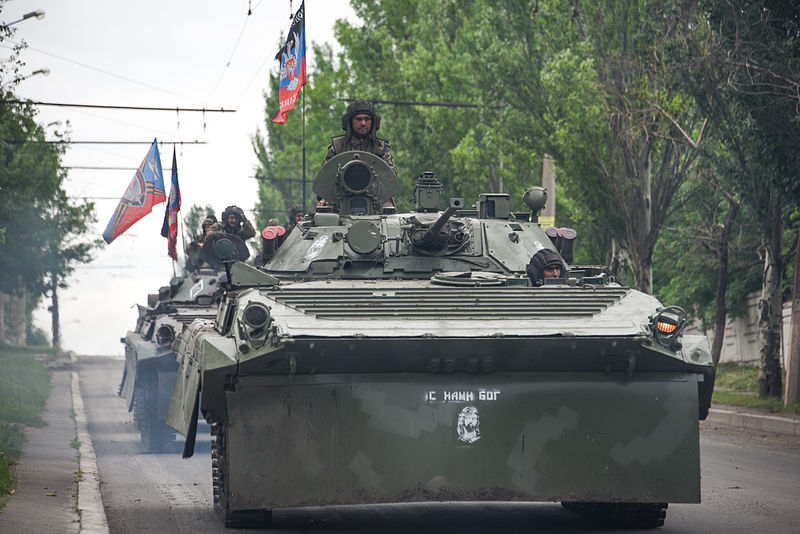
DPR (Donetsk People's Republic) BMP-2 infantry fighting vehicles in convoy, Donetsk area, may, 30, 2015.
War in the Donbass (2014-2024)
Wikipedia alleged of several hundred T-64BV and several dozen T-64BM were destroyed or captured, which seems enormous (no sources to back this up). In reality no great tank battle took place so far, with the exception of the Donetsk airport where perhaps 50+ tanks were engaged in total. But that does not rival Kursk or the Golan heights... Now as these lines are types the front line is settled between the Ukrainian government and the insurgent's Donetsk and Luhansk People's Republics. The battle of Yampil (june, 19) was another significant engagement.Another battle took place at Shakhtarsk Raion in july. However in august, well-equipped, tanks-supported pro-russian insurgents made a large counter-offensive leading to the Battle of Ilovaisk and Battle of Novoazovsk. However the Ukrainian national guard tackled the advance and retook (temporarily) Komsomolske (Starobesheve Raion, Donetsk Oblast). A ceasefire was signed in september, but not respected everywhere. Multiple clashes erupted, followed by new ceasefire in february 2015 back by France, Germany and the USA (Minsk II agreement).
Current war in Ukraine
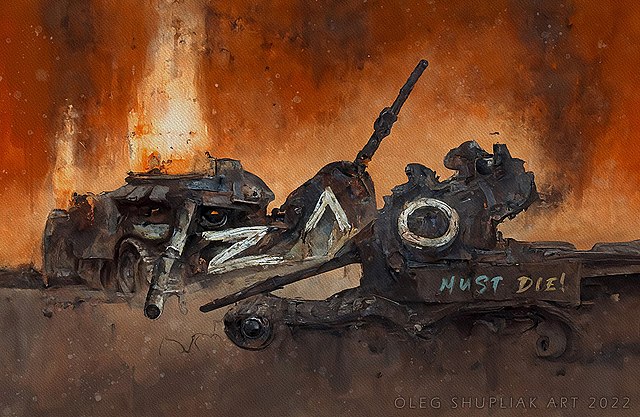
The situation in Ukraine has been a complex and ongoing issue for several years, after the situation in eastern Ukraine, particularly in the Donetsk and Luhansk regions, started in 2014 after Russia's annexation of Crimea, remained static. This border conflict already resulted in thousands of casualties and displaced persons, as well as significant political and economic ramifications for Ukraine and the broader region. Yet, On 24 February 2022, Russia invaded Ukraine in what was called by Moskow the "special operation". This happened at a total surprise for the European, despite US warnings abour troops and AFVs movements ongoing since several weeks and caught by satellites.
This invasion famously became the largest attack on a European country since World War II. As official motivation for this unprecedented operation, Pdt Vladimir Putin justify it by an operation of "denazification" (and demilitarization) and to relieve embattled troops in Donetsk and Luhansk and "persecuted" populations in the region. Until now as of Feb. 2024, second year of the war, Ukrainian civilian casualties plus military casualties amounted to hundreds. The initial offensive seemed unstoppable, the West generally believed the whole operation will be over in a mere few weeks.
But staunch resistance (also surprising the West) was encountered along the way, and by June 2022, Russian troops occupied "only" 20% of Ukrainian territory, but still damage was immense, not only in public destruction, but also with 8 million Ukrainians internally displaced, 8.2 million fleeing the country and as of April 2023 this created the largest refugee crisis, again since the last work war. There was in addition tremendous damage to the economy of Ukraine, and an ecocide, plus an unprecedented food crisis, worldwide, as Ukraine was very much one of the world's bread basket in a very inter-dependent, globalize economy.
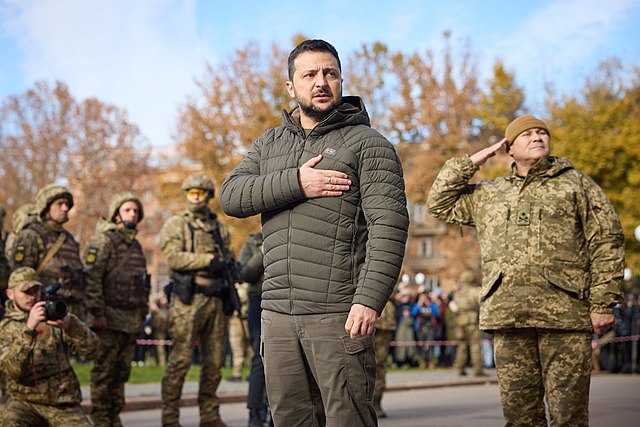
For this "special military operation" 900,000 military were deployed with hundreds of tanks, backed by 554,000 paramilitary. This seemed overwhelming to the 196,600 military and 102,000 paramilitary of Ukraine. However by July 2022 mobilization brought up to 700,000 men under arms, while the country, after the situation stabilized, fully prepared for a long reistance with all means necessary, and seeked help in the West. After all, the country was partially disarmed (and lost deterrence) folowing past agreements, backed by the West as a condition of independence.
On the Russian side, logistical challenges and stiff Ukrainian resistance completely stopped the invasion to a crawl, then full stop in most fronts after an initial full-on attack on Kiev, the capital, which failed. On the southern and southeastern fronts, Kherson (March) and Mariupol (May) were captured after the most brutal sieges ever seen, again since WW2, leaving wastelands and corpses in both cases. A renewed offensive in the Donbas and a deliberate bombing campaign on civilian targets, notably to destroy the energy grid before and during the winter were the new strategy.
But by late 2022, Ukraine, reinforced with soviet hardware in storage, notably in poland, and Czecholsovakia launched a successful counteroffensive, both in the south and east, taking new ground. Russia declared the annexation of its four partly occupied regions and by November 2022, part of the Kherson Oblast was retaken. In June 2023, Ukraine launched another counteroffensive in the southeast but it bogged down and ultimately led to no progress. Meanwhile, financial and military from the West help grew steadily and provided Ukraine with a host of new Western hardware after most of the soviet-era tanks and IFVs already had been destroyed in the largest high intensity conflict in Europe so far.
Political consequences of the invasion meant international condemnation via a UN resolution, declarations by the International Court of Justice while the Council of Europe expelled Russia and economical sanctions were voted on (with little results so far). Due to the complete cessation of economical and trade relations with the West, some 1,000 companies closed their operations. Meanwhile the International Criminal Court (ICC) opened investigations on war crimes and more serious offenses, decumented by OSINT. Nevertheless all diplomatic means to stop the conflict, notably through the Minsk agreements, failed.
To this day, after nearly two years of war, the Ukrainians resisted well, to such a point in 2022 they were compared to the Finns in WW2. The full mobilization had not yet reach its top level, 80% of the country's industries remained operational, the power grid is maintained, and despite having no Navy, the Ukrainians had the Black Sea fleet crippled whereas the air war ceased due to the heavy use of MANPADS and other SAMs. Western analysts were baffled by the poor performances of the Russian Army at large, using age-old tactics requiring little training, human waves explaining massive casualties, even use of armour that was not optimal, and poor performance of the Russian air defence as well.
Lessons for tank warfare
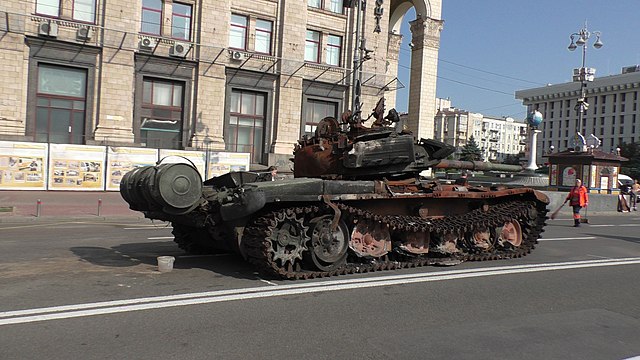
It was also observed, as Tanks losses amounted, the massive use of drones on the battlefield (mostly on the ukrainian side at first), in a way which is unprecedented in history and definitely the greatest lesson of the war. Ukrainian industry, with Western Help, went on mass-producing tens of thousands of these cheap assets, notably the efficient "Loitering munitions", waiting for an opportunity to strike, 3D-rinting the simplest ones, or using purchased, modified civilian market models. Unlike shoulder-launched ATGMs, this new asset had not been forecast, and revealed itself an adept tank killer.
It obliged Russia to spare some of its latest tanks or give them an ad-hoc "roofs" to detonate prematurely bomber-drones and Loitering munitions. Losses: 328 T-72B, 349 T-72B3, 264 T-72B3 Obr. 2016, 497 T-80BV, 97 T-80U, 112 T-80BVM, 62 T-90M, 500+ unidentified models, for MBTs alone. Observers also saw by late 2022 masses of depot tanks, refurbished and sent to the battlefield, notably antiquated T-54/55s and T-62s mostly used for infantry support during attacks. USSR had still 30,000 tanks available in 1988, most went to the depots and efforts concentrated afterwards in modernizing the T-72, T-80 and produce the T-90.
According to Oryx Spioenkop (src below), so far, Russia lost 14,393 armoured combat vehicles of which 10,065 were destroyed, 651 damaged, 742 abandoned but moreover and morte importantly 2,935 captured, fuelling the camparison with the Finns during the winter war. This seriously buffed the Ukrainian army after repairs, tanks to the common parts shared by both countries (and defence industries before the colapse of the Soviet Union).
Ukraine to compare lost 5,157 armoured vehicle, with 3,565 destroyed, 430 damaged, 202 abandoned and 960 captured. During the post-offensive lull, Russia seriously buffed up the frontline, creating deep defensive lines saturated with mines, expecting the next offensive. Delays in providing Western equipments (notably Leopard Tanks, F16 Jets) and these defenses explains the poor results of the summer 2023 Ukrainian offensive.
T-62AG

T-62AG prototype with 2002 camouflage, Illustration by Ardhya ‘Vesp’ Anargha
The T-62AG and T-62AGM were Ukrainian upgrades for the Soviet T-62 Main Battle Tank (MBT). Both upgrade kits could successfully bring any 2nd Generation T-62 MBT variant to 3rd Generation MBT standards of the early 2000s.
While the T-62AG made it to the prototype stage, the T-62AGM was just a concept, but it would have been an upgrade kit identical to the T-55AGM, just on the more modern T-62. The AGM kit was intended to fit both MBTs. A single T-62AG prototype was produced and was tested by Egypt in 2009. Unfortunately, due to the Egyptian political situation of 2011, not a single upgraded T-62 was adopted.
Links & sources -(to be expanded 2024)
Ukrainian ground forcesequipments for the Ukrainian ground force
Official website
Equipments 2022-2024 war
Oryx, Russian losses
Oryx, Ukrainian losses
Helion Publishing, whole war in Ukraine serie
Modern equipments of the Ukrainian Army
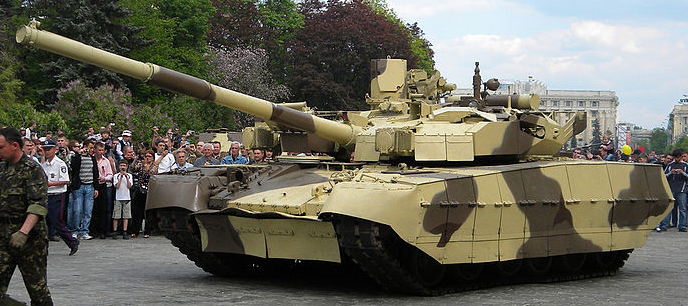
T-84BM/U Oplot (1994)An Ukrainian development of the T-80. So far, 40 in service, 120 in order for 2015.
The T-84 Oplot is a Ukrainian main battle tank (MBT) that was developed based on the Soviet T-80 series. It is a modernized version of the T-80UD, incorporating several enhancements and upgrades. The T-84 Oplot features a welded turret and hull made of composite and modular armor, which provides improved protection against various threats, including armor-piercing projectiles and anti-tank guided missiles. The tank's shape is optimized for reducing its radar signature. The primary armament of the T-84 Oplot is a 125mm smoothbore gun, capable of firing a variety of projectiles, including APFSDS (Armor-Piercing Fin-Stabilized Discarding Sabot) rounds, HEAT (High-Explosive Anti-Tank) rounds, and guided missiles. The tank carries a total of 45 rounds for its main gun. Additionally, it is equipped with a 7.62mm machine gun and a coaxial machine gun.
The T-84 Oplot is powered by a 1,200 horsepower diesel engine, which provides a maximum road speed of up to 70 km/h (43 mph). It has a range of approximately 500 kilometers (310 miles) and can traverse various terrains, including rough terrain and water obstacles, thanks to its amphibious capabilities. The tank is equipped with advanced fire control systems, including a ballistic computer, thermal sights, laser range-finders, and a stabilized gunner's sight. These systems enhance the accuracy and effectiveness of the tank's main gun and secondary armaments. The T-84 Oplot typically has a crew of three personnel, including a commander, gunner, and driver. The tank features advanced protection systems, such as explosive reactive armor (ERA) and an automatic fire suppression system, to increase crew survivability on the battlefield.
Only ten T-84 were manufactured for the Ukrainian military (6 active), a single prototype T-84-120 Yatagan, single T-84 Oplot (T-84U with new welded turret, additional ammunition compartment on the turret bustle better separated from the crew), and a single Oplot as well as a single Oplot-M. None were produced although Thailand ordered 49 Oplot-T which were delayed and delivered in 2019.
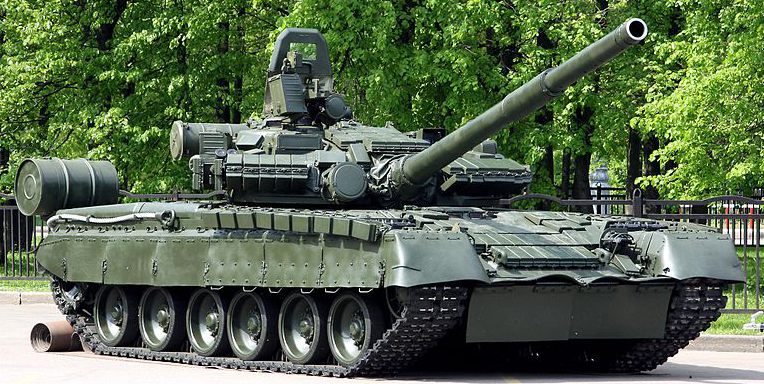
T-80BV 167 were in service but put in storage in 2015 for a complete overhaul. At least 8 were completely overhauled.

T-64BM Bulat Around 1,000 BM are in storage, pending gradual modernization. Only around 120 BM Bulat and 550 BV are maintained in service.
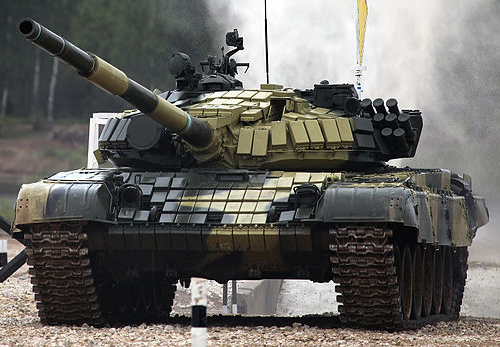
T-72BM 700 of the entire park available were sold to third world countries, 300 T-72B1 are in storage waiting for a modernization (negotiations with Poland) while around 8-12 are in service as locally modernized T-72UA1. 600 T-72M1 are also in storage.
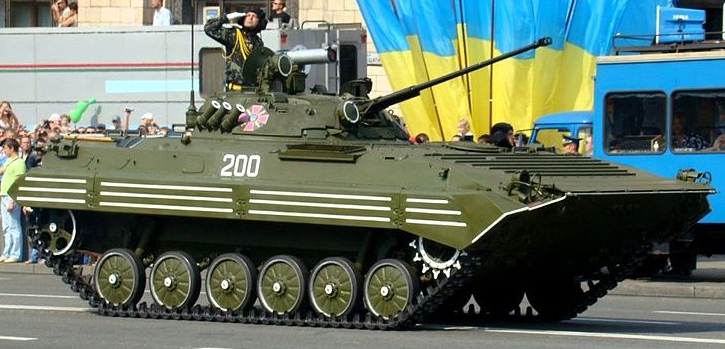
BMP-2 BMP-2s provide the mainstay of the Ukrainian IFV force, with 1,400 in service prior to the Donbass war. (1,200 today). They are completed by 4 BMP-3 and around 994 BMP-1s, 485 BMP-1K, and some 30-40 modernized BMP-1U. In addition the airborne uses 78 BMD-2, 61 BMD-1 and 44 BTR-D APCs.

BTR-4 (2005) Around 160 BMP-4s are in service. Here a BSEM-4 armoured ambulance profile (around 12 in service). The "Bucephalus" is a specifically Ukrainian 8x8 APC developed by KMDB as a private venture and revealed in 2006. They are mostly used by the airborne. Tracked APC comprises around 15 PTS-2, 2,300 MT-LBs (most being upgraded and overhauled), and 120 BTR-50s.
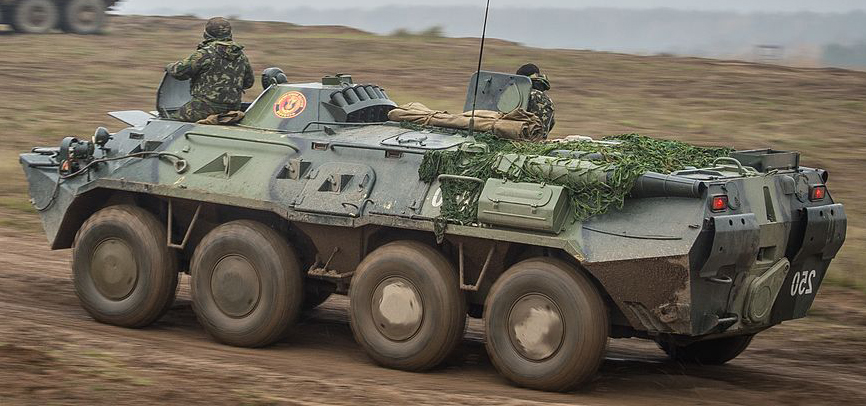
BTR-80 Around 330 BTR-80 are in service today (photo), along with 200 (over 700 -most in storage) BTR-70s, and originally 2,000+ (mostly scrapped). The modernized version BTR-7 is still in project. Less than 20 BTR-60PBs and one specialized P-145BM/PU-12 are also registered.
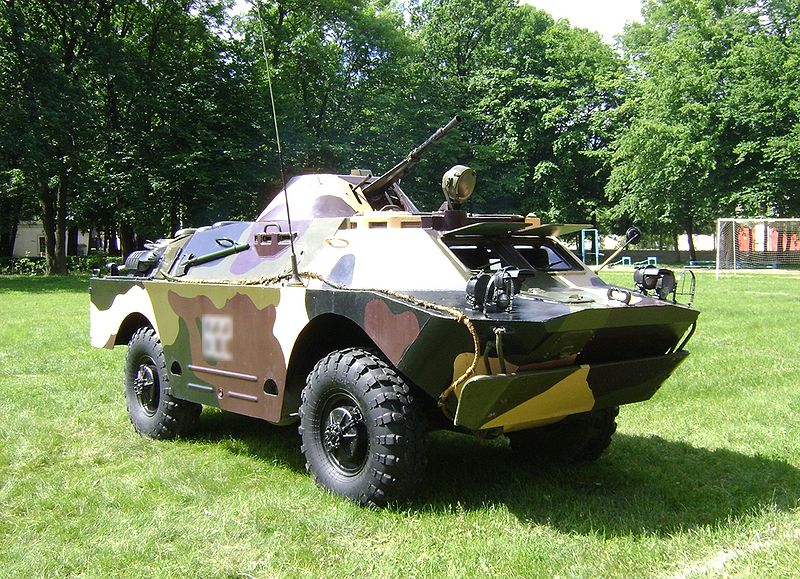
BRDM-2 Around 600 are stored, pending modernization as the BRDM-2D "Khazar". Still, 20 BRDM-Konkurs are active as tank destroyers. The fleet of BRDM-1 was scrapped, stored or used in small numbers (wfter overhaul) by Various Territorial defense battalions in the context of the 2014 war.
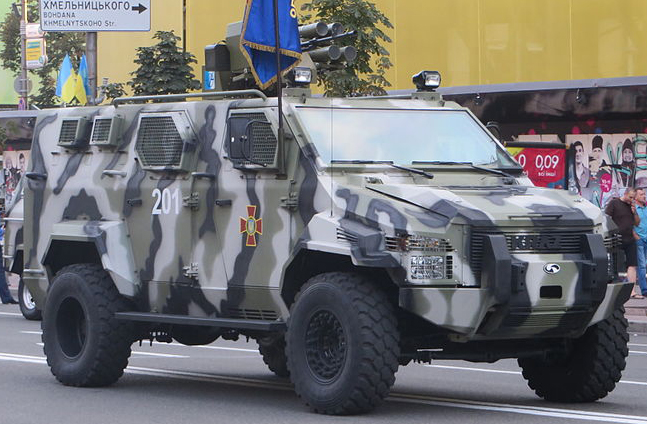
KrAZ Spartan Around 34 of these vehicles developed with Canada (2014) are used by the airborne (as 2 Kraz Shrek). 90 Italian-built Iveco LMV are on order or partly delivered. In march 2015, the US supplied also 30 M1151 Humvees.
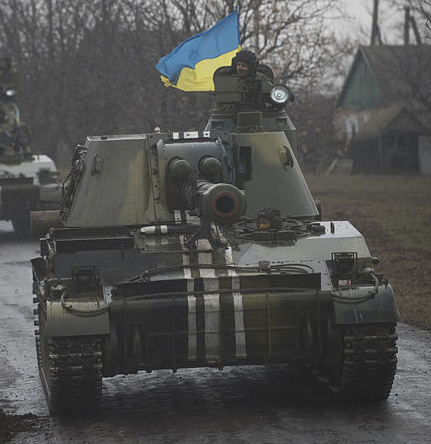
2S3 "Akatsiya" The Ukrainian SPG feet comprises 580 modern 2S3, 630 2S1 "Gvozdika" (most are in storage pending overhaul), 40 2S19 "Msta-S", 99 2S7 "Pion", 24 2S5 "Giatsint-S", 64 2S9 "Nona" (most in storage). MRLs are also mostly in storage with the exception of the 99 9A52-2 "Smerch". These stockes comprises also 50 9K52 Luna-M, 90 OTR-21 Tochka. Three Ukrainian tactical ballistic missile erectors are in development: the Sapsan, Korshun-2 and Grom-2.
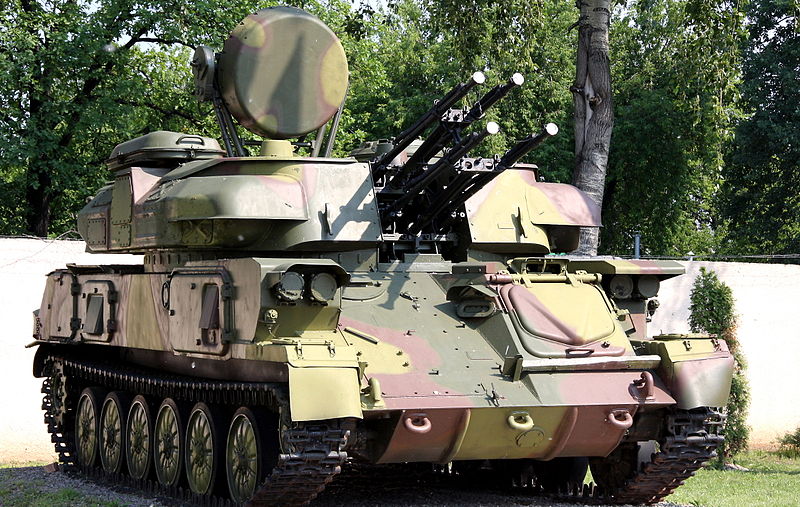
ZSU-23-4 Shilka These are modernized versions of the classic ZSU-23-4 developed in the 1970s, which had been coined as one of the best SPAAGs ever designed. However on 300 enlisted, most are in storage, pending overhaul, perhaps 20 are combat-ready. In addition, there are 70 Tunguska M1. SPAAMLs are the 9K35 Strela-10 (150), 9K33 Osa (125), and some long-range vehicle were reactivated from storage due to the war in the Donbass,36 S-200B, 80+ S-300PS, and 8 S-300V1.
Western Ukrainian Equipments:
(to come)
Modern Tanks
Modern MBTs posters

Denel Bagder (2018)

Type 16 MCV (2016)

Gepard 1A2 last rounds 2011

SANDF

Russian AFVs

Main Battle Tanks